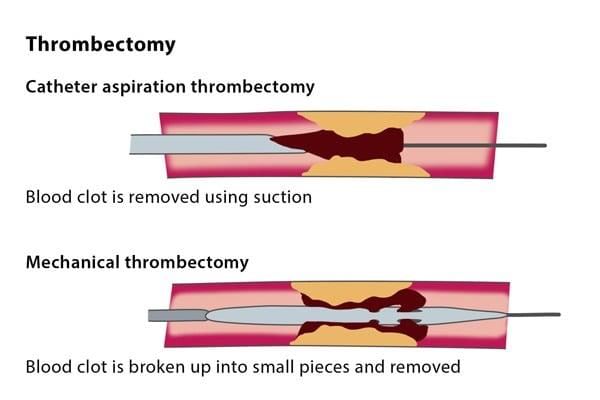UPSC Daily Current Affairs: 1st June 2025 | Current Affairs & Hindu Analysis: Daily, Weekly & Monthly PDF Download
GS3/Science and Technology
What is Thrombectomy?
Source: Business Standard
 Why in News?
Why in News?The Technology Development Board (TDB), part of the Centre's Department of Science and Technology (DST), has recently announced financial support for the creation of India's first indigenous thrombectomy device, aimed at enhancing stroke care.
Key Takeaways
- A thrombectomy is a medical procedure designed to remove blood clots from arteries or veins.
- Blood clots, also referred to as thrombi, can impede blood flow, causing tissue damage or potentially fatal outcomes.
- Timely thrombectomy is crucial for preventing serious health complications.
Additional Details
- Definition: A thrombectomy is an interventional treatment that aims to restore blood flow by removing clots that obstruct arteries or veins.
- Common Locations: Blood clots can occur in various parts of the body, including the legs, arms, intestines, brain, lungs, and heart.
- Types of Thrombectomy:There are two main types of thrombectomies:
- Surgical (Open) Thrombectomy: Involves making an incision to access the blocked vessel, removing the clot with a balloon, and repairing the vessel.
- Percutaneous (Minimally Invasive) Thrombectomy: Utilizes special devices introduced through catheters to either macerate or suction out clots, often followed by the infusion of local clot-dissolving medications.
- Thrombectomies often need to be performed swiftly, sometimes within hours, to avert life-threatening complications.
This initiative by the TDB marks a significant step towards advancing stroke treatment in India, ensuring timely and effective patient care.
GS2/International Relations
Zangezur Corridor
Source: Deccan Herald
Why in News?
The Zangezur Corridor has gained attention following a recent meeting between Armenia's Security Council Secretary and India's National Security Advisor in New Delhi. This proposed transport route is significant for regional connectivity and geopolitical dynamics in the South Caucasus.
Key Takeaways
- The Zangezur Corridor aims to connect Azerbaijan’s mainland to its exclave, the Nakhchivan Autonomous Republic, while bypassing Armenia’s Syunik Province.
- This corridor is strategically important for enhancing trade links between Azerbaijan, Turkey, and Europe.
- It has historical disputes surrounding the territory of Zangezur, which is currently part of southern Armenia.
Additional Details
- Zangezur Corridor: This proposed route will integrate with the Horadiz-Agbend transport highway and railway network on Azerbaijan's side and connect to the Nakhchivan-Igdir-Kars railway and highway on Turkey's side, facilitating a direct land route to Anatolia and beyond.
- Economic Impact: The corridor is expected to improve logistics infrastructure, reduce transportation costs, and significantly decrease travel time between Azerbaijan and Nakhchivan, enhancing regional connectivity across Caucasia and Eurasia.
- This project aims to link Turkish, Russian, Central Asian, Iranian, and Armenian territories, ultimately connecting Europe to Asia.
In summary, the Zangezur Corridor is a crucial initiative that not only promotes Azerbaijan's trade with Turkey and Europe but also plays a vital role in increasing regional connectivity across multiple nations.
GS1/History & Culture
What is the Neolithic Age?
Source: The Hindu
Why in News?
The Archaeological Survey of India recently uncovered one of the earliest rock grooves in the Kanniyakumari district, which dates back to the Neolithic age. This groove was used by people to sharpen their weapons, highlighting the significance of this period in human history.
Key Takeaways
- The Neolithic Period, also known as the New Stone Age, represents the final stage of cultural evolution among prehistoric humans.
- This era marked the transition from a nomadic lifestyle to settled farming communities, beginning around 10,000 BCE.
- Key innovations included agriculture, pottery, and the domestication of animals.
Additional Details
- Neolithic Revolution: This pivotal change began in the Fertile Crescent, where early humans first adopted farming practices, eventually spreading to regions like India and Europe.
- Characteristics: The Neolithic Age is distinguished by the development of polished stone tools, permanent settlements, and early crafts such as pottery and weaving. Houses were typically constructed from mud and reeds, often in rectangular or circular shapes.
- Alcohol production and the beginnings of architecture are notable achievements of this period, alongside the emergence of social classes as evidenced by burial practices involving status objects.
The Neolithic Revolution facilitated the establishment of permanent settlements, laying the groundwork for future advancements during the Bronze Age and Iron Age. This period saw significant developments in tools for agriculture and warfare, fostering trade and the rise of civilizations.
Towards the end of the Neolithic era, the introduction of copper metallurgy signaled a transition to the Bronze Age, marking the end of the Stone Age. Important Neolithic sites in India include Burzahom in Kashmir, Chiran in Bihar, and the Edakkal Caves in Kerala.
GS3/Environment
Amolops shillong: The Shillong Cascade Frog
Source: The Hindu
Why in News?
Scientists have recently discovered a new species of frog, named Amolops shillong, also known as the Shillong Cascade Frog. This species has been found within the urban environment of Shillong, the capital city of Meghalaya, highlighting an unexpected diversity in urban wildlife.
Key Takeaways
- New Species: Amolops shillong is a newly identified species of frog.
- Habitat: This species thrives in fast-flowing streams and has been discovered in urban forest patches of Shillong.
- Genetic Analysis: It is part of the Amolops indoburmanensis complex and is closely related to another species, Amolops siju.
- Urban Discovery: Unlike its cave-dwelling relative, A. shillong lives in busy neighborhoods, indicating the presence of important microhabitats.
- Increased Recognition: India now recognizes 20 species of Amolops, with nine identified in the last two decades, primarily from Northeast India.
Additional Details
- Amolops Genus: Frogs belonging to this genus have been known in India since the 1850s. Urban findings are rare, making this discovery significant.
- Biodiversity Hotspot: The discovery of A. shillong underscores the importance of urban areas in conserving biodiversity, particularly in regions like Northeast India.
The discovery of Amolops shillong not only adds to the biodiversity catalog of India but also emphasizes the need to preserve urban green spaces that support unique ecosystems.
GS3/Science and Technology
Vitamin B9 (Folate)
Source: Indian Express
 Why in News?
Why in News?A recent study conducted by the All-India Institute of Medical Sciences (AIIMS) reveals that approximately 41% of urban adolescents in government schools across northern India are experiencing a deficiency in folate, or vitamin B9. This deficiency may be adversely affecting their growth and development.
Key Takeaways
- Folate is the natural form of vitamin B9, essential for various bodily functions.
- It plays a critical role in the formation of red blood cells and is vital for healthy cell growth and function, especially in children.
- A significant dietary source of folate includes green leafy vegetables, legumes, citrus fruits, nuts, whole grains, and fortified cereals.
Additional Details
- Role of Vitamin B9 in Children: Folate is crucial during rapid growth phases in children. It supports the synthesis and repair of DNA and RNA, which are fundamental to genetic material.
- It facilitates the production of red blood cells and aids in the development of the central nervous system during early childhood.
- Inadequate folate intake can lead to anemia, characterized by a deficiency in the number of red blood cells.
- Proper levels of folate are essential for maintaining brain function and emotional well-being in growing children.
- Folate is also important for tissue growth and cellular repair, processes that are ongoing throughout childhood.
This information highlights the significance of ensuring adequate folate intake among children to support their overall health and development.
GS3/Defence & Security
Impact of Military Standoffs on Aviation
Source: The Hindu
 Why in News?
Why in News?Following the terror attack in Pahalgam on April 22, India took measures against Pakistan by suspending the Indus Waters Treaty. In retaliation, Pakistan issued a NOTAM (Notice to Airmen), closing its airspace to Indian aircraft from April 24 to May 23. India responded with similar airspace restrictions starting April 30, which also lasted until May 23.
Key Takeaways
- India and Pakistan imposed reciprocal airspace closures affecting numerous flight routes.
- Historical context of airspace restrictions includes significant military conflicts and incidents.
- Projected economic impacts reveal substantial losses for the aviation sectors of both countries.
Additional Details
- NOTAM: A NOTAM is an official alert issued to pilots and airlines regarding temporary changes or hazards in flight operations, such as airspace closures or route changes that may affect flight safety.
- Historical Incidents:
- 1950s: India opposed Pakistan's discriminatory prohibited zone near the border, resolved through diplomatic channels.
- 1965 War: Resumption of overflights post-war highlighted the importance of valid security reasons for airspace restrictions.
- 1971 Hijacking: Following the hijacking of an Indian Airlines flight, India imposed a ban on overflights, leading to legal disputes.
- Subsequent conflicts, like the Kargil War (1999) and Balakot strikes (2019), reaffirmed airspace as a strategic tool.
- Economic Losses:
- 2002: Estimated losses due to airspace closure were ₹40 crore for Air India and ₹3.4 crore for Indian Airlines.
- 2019: Indian carriers reported losses of ₹548.93 crore following the Balakot strikes.
- 2025 Projections: Estimated losses for the Indian aviation sector could reach ₹7,000 crore.
- Operational Challenges:
- 32 airports in northern and western India were temporarily closed, impacting air traffic management.
- Limited available route segments in the Delhi and Mumbai FIRs forced rerouting, complicating air traffic control.
The ongoing military standoffs have profound implications for aviation, leading to substantial economic losses and operational challenges. The international aviation law's role in mitigating these issues heavily depends on the political dynamics between India and Pakistan.
GS2/Governance
What is DHRUVA (Digital Hub for Reference and Unique Virtual Address)?
Source: The Week
Why in News?The Department of Posts has introduced an innovative digital initiative known as DHRUVA—Digital Hub for Reference and Unique Virtual Address. This initiative aims to enhance the digital infrastructure related to addresses across India.
Key Takeaways
- DHRUVA establishes a nationwide Digital Address Digital Public Infrastructure (DPI).
- It aims to create a standardized, geo-coded, interoperable digital address system.
- The framework emphasizes secure, consent-based sharing of address information.
- It introduces the concept of Address-as-a-Service (AaaS) for effective address data management.
Additional Details
- Address-as-a-Service (AaaS): This model facilitates efficient, secure, and user-controlled management of address data, promoting real-time sharing of verified information among citizens, government bodies, and businesses.
- Interoperability: Ensures that different address systems can work together seamlessly across various sectors.
- Standardization: Focuses on uniform address formats and geolocation tagging to streamline processes.
- Public-Private Integration: Encourages collaboration between public and private sectors for innovation and adoption.
- DHRUVA is designed to support various applications, including e-governance, online commerce, urban planning, and emergency services.
- The platform will provide multilingual support and integration with existing identity systems, like Aadhaar, enhancing accessibility for all users.
- DHRUVA builds upon the previously launched Digital Postal Index Number (DIGIPIN), a geo-coded addressing system developed in collaboration with IIT Hyderabad and ISRO.
The DHRUVA initiative not only aims to revolutionize how addresses are managed in India but also empowers citizens to control their digital address identity, allowing them to manage access, update their information, and securely share their verified address for various purposes.
GS3/Economy
Trump Doubles Steel Tariffs to 50% - Implications for Global Trade and India’s Exports
Source: Indian Express Why in News?
Why in News?
The announcement by US President Donald Trump to increase steel import tariffs from 25% to 50% aims to further protect and revitalize the US steel and aluminum industries. This new tariff will take effect from June 4th, and has been described as "unfortunate" by Indian exporters, who foresee complications in ongoing trade discussions. This tariff hike follows an earlier increase earlier this year when tariffs were raised to 25%.
Key Takeaways
- The new tariff increase is part of a broader strategy to support domestic industries.
- Indian exporters are concerned about the impact on trade negotiations and exports.
Additional Details
- Legal Basis: The US Trade Expansion Act of 1962 permits the President to impose tariffs if imports threaten national security. Trump previously utilized this to impose 25% tariffs on steel and 10% on aluminum in 2018.
- Purpose: Announced during a rally at a steel plant in West Mifflin, Pennsylvania, Trump justified the hike as a move to "Make America Great Again," aiming to bolster domestic production.
- Impact on Indian Exporters: The Engineering Export Promotion Council (EEPC) noted that previous tariff increases already reduced exports to the US by around $5 billion in the iron and steel sector.
- The Federation of Indian Exporters’ Organisation (FIEO) indicated that the new tariffs could adversely affect semi-finished and finished product exports, including stainless steel pipes and automotive steel parts.
The economic implications of this tariff increase are far-reaching. With US steel prices projected to rise to $1,180 per metric tonne, domestic industries such as automobile and construction may face increased costs. India's total exports to the US in FY 2025 for iron, steel, and aluminum products stand at approximately $4.56 billion, comprising:
- Iron and Steel: $587.5 million
- Articles of Iron/Steel: $3.1 billion
- Aluminum and Related Products: $860 million
Strategically, India has filed a formal notice with the World Trade Organization (WTO) and may retaliate with tariffs on select US goods within a month. The Indian iron and steel industry, which contributes about 2% to the GDP, is the second-largest steel producer globally, and is essential for India's manufacturing ambitions under initiatives like Make in India.
In conclusion, Trump's decision to double steel import tariffs signifies a notable shift towards protectionism, which could reshape global trade dynamics and challenge India's export strategies. As trade agreements evolve, India must balance protecting its exporters with maintaining strong bilateral relations with the United States.
GS3/Environment
Key Facts about Netravati River
Source: DTE
Why in News?
Continuous rainfall in the Dakshina Kannada district has resulted in a significant rise in the water level of the Netravati River, leading to precautionary evacuations of residents from low-lying areas.
Key Takeaways
- The Netravati River is a major west-flowing river in Karnataka, often referred to as the lifeline of Dakshina Kannada.
- It is crucial for the region's sustainability and provides water to the cities of Bantwal and Mangalore.
- The river has a total length of 103 km and drains an area of 3,657 sq.km.
Additional Details
- Course: The Netravati River originates in the Bangrabalige Valley of Yelaneeru Ghat in the Kudremukha range of the Western Ghats at an elevation of approximately 1,300 meters in Chikkamagaluru district. It merges with its major tributary, the Kumaradhara River, at Uppinangadi before flowing into the city of Mangalore and eventually joining the Arabian Sea.
- Climate: The climate of the river basin is characterized by heavy rainfall and high humidity, with oppressive weather during the hot season.
- The town of Bantwal, located on its banks, was historically referred to as the Bantwal River.
- The river also flows through the notable pilgrimage site of Dharmasthala.
In summary, the Netravati River plays a vital role in the ecology and economy of the Dakshina Kannada region, providing essential water resources and supporting local communities.
GS1/History & Culture
PM Modi Takes Part in 300th Birth Anniversary of Ahilyabai Holkar
Source: The Hindu
Why in News?
On the occasion of the 300th birth anniversary of Lokmata Devi Ahilyabai Holkar, Prime Minister Narendra Modi addressed the Mahila Sashaktikaran Mahasammelan in Bhopal, emphasizing her legacy in public service and nation-building. During the event, he released a commemorative postage stamp and a special coin, worth Rs 300, featuring a portrait of Ahilyabai Holkar. Additionally, he honored a woman artist with the National Devi Ahilyabai Award for her contributions to tribal, folk, and traditional arts.
Key Takeaways
- PM Modi's address celebrated the contributions of Ahilyabai Holkar to Indian society.
- The release of a commemorative coin and stamp symbolizes her enduring legacy.
- Recognition of women in arts through the National Devi Ahilyabai Award.
Additional Details
- Ahilyabai Holkar: Born on May 31, 1725, in Chondi village, she was a pioneering ruler known for her educational initiatives for women and effective governance.
- Rise to Power: Following the death of her husband in 1754, Ahilyabai petitioned for her sovereignty over Malwa in 1765, marking a significant moment in women's leadership in India.
- Legacies in Governance: Historians, including Jawaharlal Nehru, praised her 30-year reign (1765–1795) for stability and prosperity, keeping Malwa free from the conflicts that plagued Central India.
- Cultural Contributions: She transformed Maheshwar into a cultural hub, supporting literature, arts, and temple reconstruction, notably the Kashi Vishwanath temple in 1780.
- Social Reforms: Ahilyabai was a pioneer in advocating for widow remarriage, women's property rights, and women's safety initiatives.
The speech by PM Modi not only commemorated Ahilyabai Holkar's historical contributions but also connected her legacy to contemporary efforts in promoting women-led development and inclusive growth in India. This celebration serves as an inspiration for modern initiatives aimed at empowering women across various sectors, reinforcing the idea of Nari Shakti as a vital element in India's progression.
GS3/Science and Technology
IndiaAI Mission: Strengthening Indigenous AI Capabilities
Source: PIB
Why in News?
The recent selection of three new startups to contribute to the development of India's Foundation Model under the IndiaAI Mission marks a crucial advancement in enhancing the country's indigenous artificial intelligence capabilities.
Key Takeaways
- The IndiaAI Mission was launched as a collaborative effort between the Ministry of Electronics and Information Technology and Nasscom in 2023.
- The initiative aims to enhance India's AI ecosystem by providing access to high-end computing resources for startups and researchers.
Additional Details
- Mission Goals:The mission focuses on two primary objectives:
- Making AI in India: This initiative encourages the development of artificial intelligence technologies within the country.
- Making AI Work for India: It aims to ensure that AI technologies deliver benefits across various sectors in India.
- Implementing Agency: IndiaAI, a dedicated business division under the Ministry of Electronics and Information Technology (MeitY), will serve as the implementing body for the mission.
- The mission is designed to democratize AI benefits, bolster India's position as a global leader in AI, and promote ethical and responsible usage of AI technologies.
- Pillars of the IndiaAI Mission:
- Common Compute Facility
- AI Kosha (IndiaAI Datasets Platform)
- AI Safety Institute of India (Upcoming)
- IndiaAI Innovation Centre
- AI Application Development Initiative
- Future Skills Initiative
- Startup Financing
The IndiaAI Mission represents a significant step toward establishing a robust AI ecosystem in India, ensuring that the benefits of AI technology are accessible and can be leveraged effectively across various sectors.
GS3/Environment
Kawal Tiger Reserve Declared as Kumram Bheem Conservation Reserve
Source: The Hindu
Why in News?
The Telangana State government has taken a significant step by declaring the tiger corridor area that connects the Kawal Tiger Reserve with the Tadoba-Andhari Tiger Reserve in Maharashtra as the 'Kumram Bheem Conservation Reserve'. This decision aims to bolster conservation efforts and protect the vital wildlife corridors.
Key Takeaways
- The Kumram Bheem Conservation Reserve connects Kawal Tiger Reserve with Tadoba-Andhari Tiger Reserve.
- The reserve is located in the southern-most tip of the Central Indian Tiger Landscape.
- The area is characterized by Southern Tropical Dry Deciduous Forest vegetation.
Additional Details
- Kawal Tiger Reserve: This reserve is nestled within the Sahyadri Mountain Ranges and serves as a crucial habitat for tigers, having linkages with the Tadoba-Andhari (Maharashtra) and Indravati (Chhattisgarh) tiger reserves.
- Conservation Reserve Declaration: According to Section 36(A) of the Wildlife Protection Act of 1972, the state government is empowered to declare areas adjacent to national parks and sanctuaries as conservation reserves to protect landscapes, flora, fauna, and their habitats.
This declaration not only enhances the protection of wildlife but also ensures the preservation of ecological balance in the region. The establishment of the Kumram Bheem Conservation Reserve is a proactive measure towards environmental conservation and biodiversity protection.
|
51 videos|5378 docs|1139 tests
|
FAQs on UPSC Daily Current Affairs: 1st June 2025 - Current Affairs & Hindu Analysis: Daily, Weekly & Monthly
| 1. What is thrombectomy and when is it typically used? |  |
| 2. What is the significance of the Zangezur Corridor in regional geopolitics? |  |
| 3. What are the defining characteristics of the Neolithic Age? |  |
| 4. What are the key features of the Shillong Cascade Frog (Amolops shillong)? |  |
| 5. How does Vitamin B9 (Folate) affect human health? |  |
















